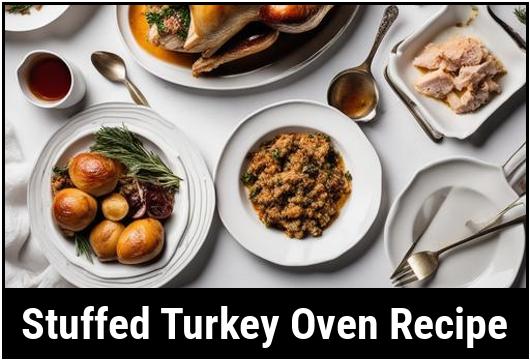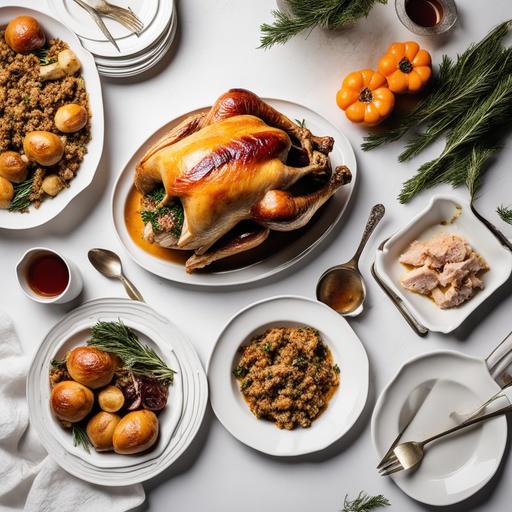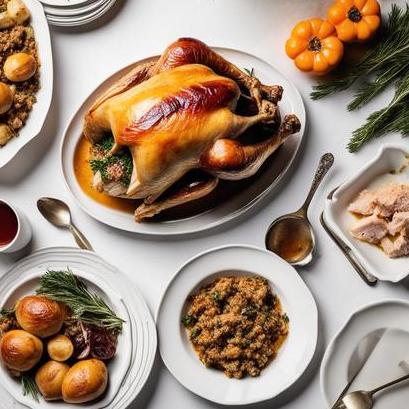
Comprehensive Guide To Stuffed Turkey Oven Recipe
In this comprehensive guide, we will delve into the wonderful world of stuffed turkey oven recipes. Buckle up and get ready for a deep dive into the food science, culinary details, selection, cleaning, preparation, tips, variations, doneness checks, and of course, a delicious recipe!
I. Food Science behind Stuffed Turkey
Understanding the food science behind cooking a stuffed turkey is crucial for achieving the desired deliciousness and avoiding any potential mishaps. As we know, turkey is a lean meat that tends to dry out easily. The stuffing, however, adds moisture and infuses flavors into the bird during the cooking process. This interaction between the turkey and the stuffing is what makes this recipe so delightful.
II. Culinary Considerations
1. Selecting a Quality Turkey
Choosing the right turkey is essential for a perfect outcome. Look for a fresh turkey that has been properly refrigerated and has a plump appearance. The skin should be intact without any blemishes or discoloration. If you prefer a more flavorful bird, consider a heritage breed turkey.
2. Cleaning and Handling the Turkey
Before cooking, ensure that the turkey is thoroughly cleaned, both inside and out. Rinse the bird under cold water, removing any remaining feathers, giblets, and excess fat. Pat it dry with paper towels before moving on to the next step.
3. Preparation and Flavor Enhancements
To infuse additional flavors into your turkey, you can use a brine or a dry rub. Brining involves soaking the turkey in a saltwater solution, while a dry rub consists of a mixture of herbs, spices, and other seasonings. Both methods enhance the taste and tenderness of the meat.
III. Tips for Preparing the Perfect Stuffed Turkey

Now that we understand the culinary considerations, let’s delve into the preparation process for the perfect stuffed turkey.
1. Preparing the Stuffing
The stuffing is a key component of this recipe, and there are countless variations to suit different tastes. A classic stuffing is made with ingredients like bread crumbs, onions, celery, herbs, and spices. It’s important to fully cook the stuffing before placing it inside the turkey to avoid any potential food safety risks.
2. Trussing the Turkey
Trussing is a technique that involves tying the turkey’s legs together and securing the wings to the body using kitchen twine. This helps the turkey cook evenly and maintain its shape during the cooking process.
3. Stuffing the Turkey
Gently stuff the turkey’s cavity with the prepared stuffing, being careful not to overpack it as this can hinder proper cooking. Allow enough space for the heat to circulate inside the bird.
4. Basting and Seasoning
To prevent the turkey from drying out, basting is a crucial step. Baste the turkey with melted butter or its own cooking juices every 30 minutes to keep it moist and flavorful. Season the outside of the turkey with salt, pepper, and any desired herbs or spices to enhance the overall taste.
IV. Variations and Flavorful Twists
While the classic stuffed turkey recipe is already mouthwatering, there are several variations and flavorful twists you can experiment with to tantalize your taste buds.
1. Sausage and Apple Stuffing
Elevate your stuffing by adding cooked sausage and diced apples to the traditional mix. The savory and sweet combination adds a delightful twist to the dish.
2. Wild Rice and Mushroom Stuffing
For a more earthy and robust flavor, consider using wild rice and sautéed mushrooms in your stuffing. This variation pairs exceptionally well with turkey, adding depth and complexity to the overall taste.
3. Mediterranean Herb-Infused Stuffing
Give your stuffing a Mediterranean twist by incorporating flavors like oregano, rosemary, and sun-dried tomatoes. This variation adds a burst of herbal freshness and richness to the turkey.
V. Doneness Checks and Cooking Time

Ensuring your turkey is cooked to perfection is crucial for both flavor and food safety. Here are some doneness checks and general guidelines for cooking times:
1. Internal Temperature
The internal temperature of the turkey is the most reliable indicator of doneness. Insert a meat thermometer into the thickest part of the bird without touching the bone. The turkey is safe to eat when it reaches a minimum internal temperature of 165°F (74°C).
2. Cooking Time
The cooking time will vary depending on the weight of your turkey. As a general guide, calculate around 15-20 minutes of cooking per pound (0.45 kg) at a constant temperature of 325°F (163°C). However, it’s always recommended to use a meat thermometer to ensure accuracy.
VI. Stuffed Turkey Oven Recipe – A Delight for the Senses
Now that we’ve covered the food science, culinary considerations, preparation tips, and variations, it’s time to unveil a delicious stuffed turkey oven recipe.
Stuffed Turkey Oven Recipe
Ingredients:
-
1 fresh turkey (12-15 lbs)
-
1 batch of classic stuffing (or your favorite variation)
-
Salt and pepper for seasoning
-
1 cup melted butter
Instructions:
-
Preheat your oven to 325°F (163°C).
-
Clean the turkey thoroughly, removing any remaining feathers, giblets, and excess fat. Pat it dry with paper towels.
-
Prepare your desired stuffing variation following the chosen recipe.
-
Truss the turkey by tying its legs together and securing the wings to the body using kitchen twine.
-
Gently stuff the turkey’s cavity with the prepared stuffing, leaving enough space for heat circulation.
-
Season the outside of the turkey generously with salt and pepper.
-
Place the stuffed turkey on a rack in a roasting pan, breast side up.
-
Brush the turkey with melted butter, ensuring it is fully coated.
-
Place the roasting pan in the preheated oven and roast according to the cooking time guidelines discussed previously.
-
Baste the turkey with melted butter or its own cooking juices every 30 minutes.
-
Use a meat thermometer to check for doneness by inserting it into the thickest part of the bird. It should reach an internal temperature of 165°F (74°C).
-
Once fully cooked, remove the turkey from the oven and let it rest for at least 20-30 minutes before carving.
-
Serve the delicious stuffed turkey alongside your favorite side dishes and enjoy!
VII. Final Thoughts
Cooking a stuffed turkey in the oven is a culinary delight that brings joy to holidays and gatherings. Understanding the food science, considering culinary details, and using quality ingredients will result in a succulent and flavorful bird. With the tips, variations, and a carefully detailed recipe provided in this guide, you are now equipped to embark on your own stuffed turkey oven adventure. Enjoy the process, experiment with flavors, and savor the rewarding experience of serving a deliciously stuffed turkey to your loved ones. Happy cooking!
Sources
FAQS On Stuffed Turkey Oven Recipe
What Are The Ingredients Needed For A Stuffed Turkey Oven Recipe?
To prepare a delicious stuffed turkey using the oven, you will need the following ingredients:
- 1 whole turkey (approximately 12-15 pounds)
- 1 cup diced onion
- 1 cup diced celery
- 1 cup diced carrot
- 4 cloves of garlic, minced
- 1 tablespoon fresh thyme leaves
- 1 tablespoon fresh rosemary leaves
- 1 tablespoon fresh sage leaves
- 1 cup breadcrumbs
- 1 cup chicken or turkey broth
- Salt and black pepper to taste
- ½ cup unsalted butter, softened
- Cooking twine or kitchen string
How Do I Properly Stuff The Turkey For This Oven Recipe?
To stuff the turkey, start by rinsing it thoroughly with cold water and patting it dry with paper towels. In a large bowl, combine the diced onion, celery, carrot, minced garlic, thyme, rosemary, sage, breadcrumbs, and salt and pepper. Mix well until all ingredients are evenly incorporated. Position the turkey so the neck cavity is facing up and loosely stuff the neck cavity with the prepared stuffing. Then, stuff the larger cavity of the turkey with the remaining stuffing mixture. Be sure not to overstuff, as this may affect the turkey’s cooking time and result in an unevenly cooked bird.
What Is The Ideal Cooking Time And Temperature For The Stuffed Turkey In The Oven?
Preheat your oven to 325°F (165°C). Once the oven has reached the desired temperature, place the stuffed turkey on a roasting rack inside a roasting pan, breast side up. Brush the turkey with the softened butter, ensuring it is evenly coated. Cover the turkey loosely with aluminum foil. The general rule of thumb is to cook the stuffed turkey for around 15 minutes per pound. Therefore, a 12-15 pound turkey would take approximately 3 to 3.75 hours to cook. However, it is crucial to use a meat thermometer to ensure the internal temperature of the turkey reaches 165°F (74°C) in the thickest part of the thigh. This will guarantee it is fully cooked and safe to eat.
How Often Should I Baste The Stuffed Turkey While It Is In The Oven?
Basting the turkey is an essential step in keeping it moist and flavorful. To baste the turkey, remove it from the oven every 30 minutes, using a baster or spoon to collect the pan juices. Carefully pour the pan juices over the turkey, making sure to cover all areas. Basting too frequently may cause the oven temperature to drop, so try to work quickly and effectively to maintain the heat.
Should I Cover The Stuffed Turkey With Foil Throughout The Entire Cooking Process?
It is recommended to cover the stuffed turkey with foil for the first 2 to 2.5 hours of the cooking process. This helps to retain moisture and prevent the skin from becoming excessively browned or burnt. After this initial period, remove the foil to allow the turkey’s skin to brown and crisp up, creating an appealing texture. Remember to monitor the browning process to avoid excessive charring.


